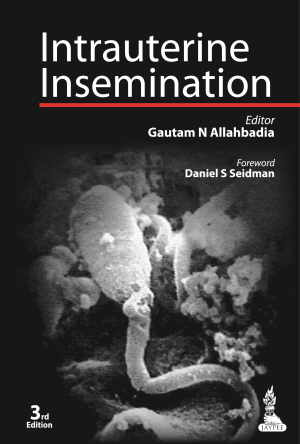Intrauterine insemination (IUI), also known as artificial insemination, is a fertility treatment that uses a catheter
to place washed sperm directly into the uterus. Its aim is to increase the number of sperm reaching the fallopian tubes
and subsequently increase the chances of fertilisation (American Pregnancy Association).
The second edition of Intrauterine Insemination brings physicians and trainees fully up to date with the latest
developments in the technique.
Divided into 48 chapters, this comprehensive guide covers every aspect of the procedure, from patient selection and
clinical assessment of couples, to ovarian induction, predictors of ovarian response, modulation of sperm motility, and
sperm banking. The final sections describe data management issues, sex pre-selection, and regulation of assisted
reproductive technologies.
Key points
•New edition presenting latest developments in IUI
•Covers all aspects of the procedure
•Includes more than 150 images, illustrations and tables
•Previous edition published in 2005
Author information
Gautam N Allahbadia MD DNB FNAMS
Consultant Fertility Physician, Dr LH Hiranandani Centre for Human Reproduction, Mumbai; Director IVF, The Prince Aly
Khan Centre for Human Reproduction, Mumbai; Scientific Director, Rotunda - The Centre for Human Reproduction, Mumbai,
India
Rubina Merchant MD
Deccan Fertility Clinic, Rotunda – The Centre for Human Reproduction, Mumbai, India
Table of Contents
Molecular Regulation of Key Events that Play a Role in Successful Mammalian Fertilization
Spermatogenesis, Sperm Maturation and Sperm-Oocyte Interaction in Human
Patient Selection and Management to Optimize Success in an Intrauterine Insemination
Program
IUI: Indications, Results and Outcomes
Intrauterine Insemination as a Treatment Option in Resource Limited Medical Settings
First-line Treatment for Unexplained Infertility in Women over 40 Years of Age-ovulation
Induction and IUI, or IVF?
Ovulation Induction for IUI
Predictors of Ovarian Response to Stimulation for Intrauterine Insemination
Role of Recombinant Gonadotropins in an IUI Program—Current Protocols
Recombinant FSH versus Clomiphene Citrate for Ovarian Stimulation in Couples with
Unexplained Infertility and Male Subfertility Undergoing IUI
The use of GnRH Antagonists in Ovarian Stimulation for Intrauterine Insemination
Clomiphene Citrate Stimulated or Natural Cycle IUI?
Aromatase Inhibitors versus Clomiphene Citrate for Superovulation in Patients with
Unexplained Infertility Undergoing IUI
Strategies in Prevention of the Ovarian Hyperstimulation Syndrome
Efficacy of Unstimulated Intrauterine Insemination in Advanced Age Women
How to Set Up a Laboratory for an IUI Program
Novel Methods for Sperm Separation and Isolation
Intrauterine Insemination Techniques
The Influence of Timing Intrauterine Insemination and the Number of Inseminations on
Pregnancy Outcome
Single versus Double Intrauterine Insemination in Multi-follicular Ovarian Hyperstimulation
Cycles
Endometrial Thickness and Pregnancy Outcome after Intrauterine Insemination
Ultrasound in the Investigation and Monitoring of Infertility
Can Periovulatory Follicular Volumen and Vascularization Determined by 3D and Power
Doppler Sonography Predict the IUI Outcome?
Evaluation of the Impact of Sperm Characteristics on the Outcome of Intrauterine
Insemination
Modulation of Sperm Motility
The Physiology of the Spermatozoon and the use of Digitally Enhanced Sperm Analysis in
Predicting Pregnancy after Intrauterine Insemination
Effect of Swim-up and Gradient as Semen Preparation Techniques on the Outcome of
Intrauterine Insemination
Effect of Male Factor on Pregnancy Outcome in Patients Undergoing Intrauterine
Insemination
Sperm Surface Antibodies: IUI or IVF
Luteal Phase Support during Intrauterine Insemination Cycles-does it Influence the
Outcome?
Luteal Phase Support in Stimulated Intrauterine Insemination Cycles: Is there a Need for it?
Efficacy and Safety of IUI in HIV Serodiscordant Couples where the Man is Positive
Complications of Intrauterine Insemination
Stimulated IVF with Elective Single Embryo Transfer Versus IUI for Unexplained Subfertility
Goals and Significance of Semen Cryopreservation for IUI
Human Sperm Banking
The Value of Semen Cryopreservation Combined with IUI for Infertile Men with
Oligozoospermia and Asthenozoospermia
Assessment of Sperm Cryodamage and Strategies to Improve Outcome
The Significance of Excess Oocyte Aspiration and Vitrification in Patients Undergoing
Stimulated IUI
IVF Conversion to IUI in Poor Responders to Gonadotropin Stimulation: Is it Advantageous?
Intrauterine Insemination versus Fallopian Tube Sperm Perfusion for Non-tubal Subfertility
The Role of the Andrologist in an Intrauterine Insemination Program
Role of the Nurse Coordinator in an IUI Program
Data Management for an IUI Clinic
Is there a Role for Intrauterine Insemination in the 2000’s?
Computerization of an Andrology and IUI Program
Sex Pre selection; A Never Ending Story
Regulation of Assisted Reproductive Technologies Including IUI Programs


